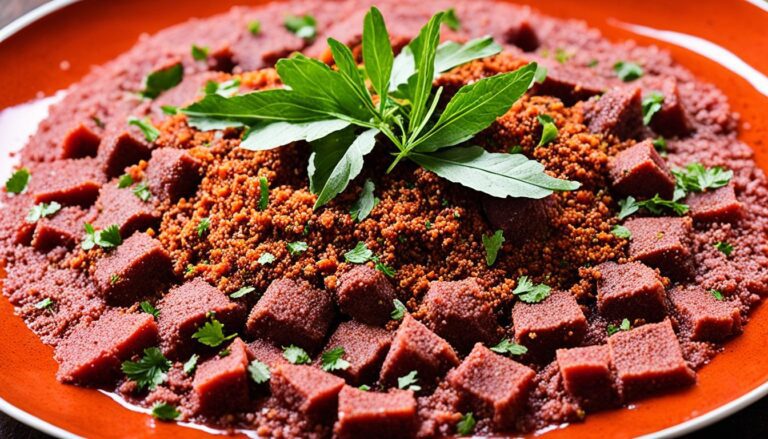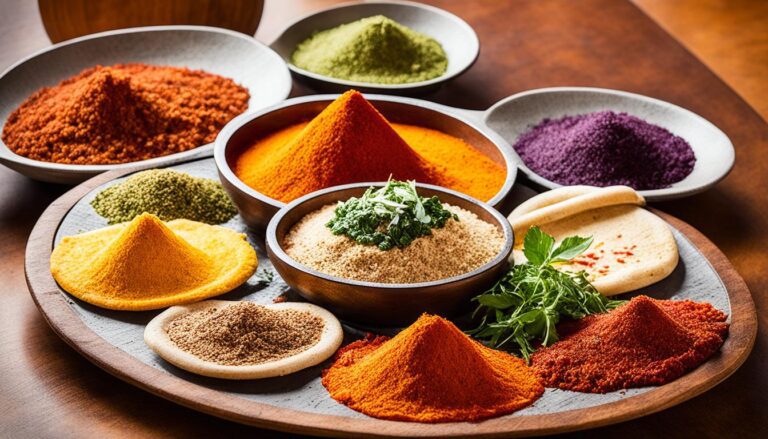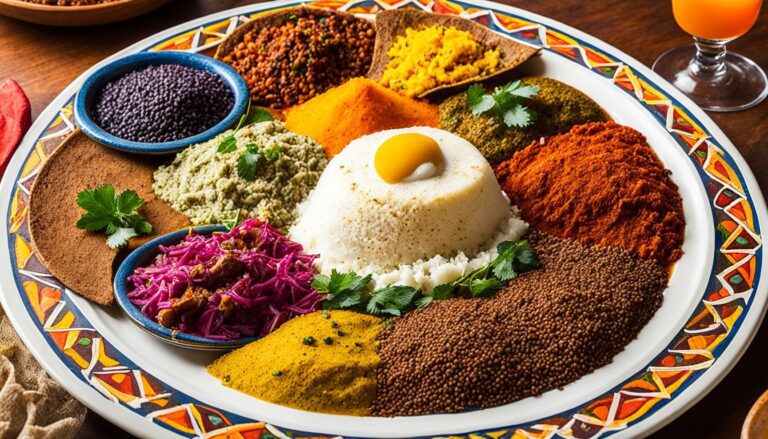Does Ethiopian Food Use Soy?
Welcome to our culinary exploration of Ethiopian cuisine, where we unravel the mysteries of this rich and flavorful culinary tradition. Today, we pose a thought-provoking question: Does Ethiopian food, known for its vibrant spices and diverse flavors, incorporate soy into its traditional dishes? Join us as we embark on a journey to uncover the answer and discover the unique elements that define Ethiopian cuisine.
Introduction to Ethiopian Cuisine
Before we delve into the question at hand, let’s first familiarize ourselves with the vibrant and diverse world of Ethiopian cuisine. Ethiopian food is not just about nourishment; it is an expression of the country’s cultural heritage and a reflection of its rich history. With its unique flavors and tantalizing aromas, Ethiopian cuisine has captured the hearts of food enthusiasts worldwide.
Ethiopian cuisine is known for its distinct use of spices, which play a vital role in creating the bold and complex flavors that define the dishes. These spices are not only used for their taste but also for their cultural and medicinal significance. From the fiery berbere spice blend to the earthy and aromatic flavors of mitmita, spices are the essence of Ethiopian cooking.
Cultural heritage is deeply intertwined with Ethiopian food. It is customary in Ethiopian culture to eat with your hands, using injera, a sourdough flatbread made from teff flour, as a vessel for scooping up the various dishes. This communal dining experience emphasizes the importance of sharing and connection in Ethiopian society.
To visually immerse yourself in the world of Ethiopian cuisine, take a moment to savor this image of a colorful Ethiopian platter:
By embracing the culinary traditions of Ethiopia, we embark on a journey to honor its cultural heritage and savor the flavors that have been passed down through generations. Let’s explore the key ingredients and traditional dishes that make Ethiopian cuisine a truly unforgettable experience.
Key Ingredients in Ethiopian Cuisine
To truly appreciate the unique flavors and tastes of Ethiopian dishes, it is essential to understand the key ingredients that contribute to their distinctive character. In this section, we will explore the staple elements that form the foundation of Ethiopian cuisine: injera, berbere, teff, and spices.
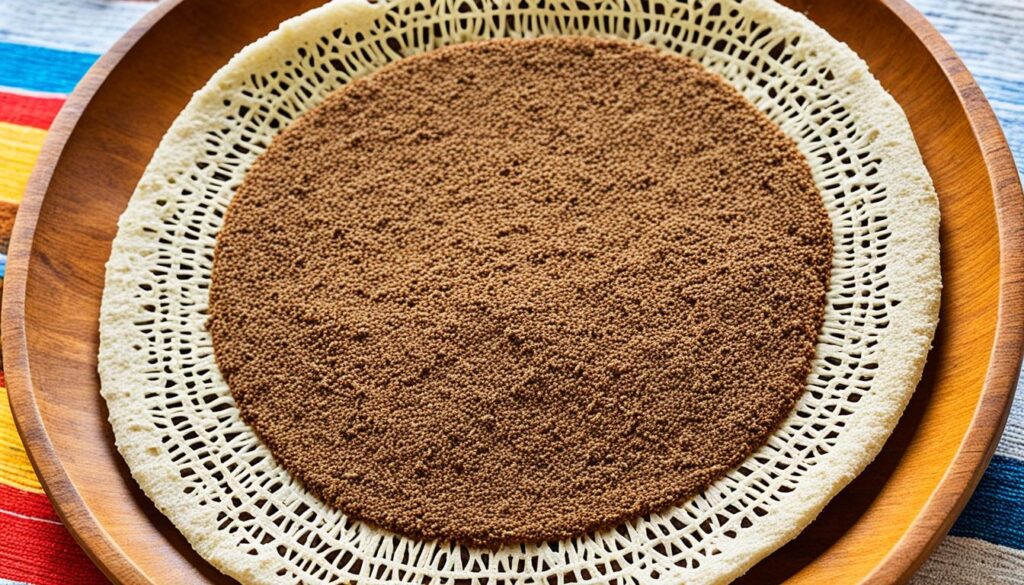
Injera: The Traditional Flatbread
At the heart of Ethiopian cuisine is injera, a sourdough flatbread that serves as a versatile base for many dishes. Made from teff flour, a gluten-free grain that is native to Ethiopia, injera has a slightly tangy flavor and a porous texture that absorbs the rich flavors of the accompanying dishes.
Berbere: The Fiery Spice Blend
No discussion of Ethiopian cuisine would be complete without mentioning berbere, a vibrant and aromatic spice blend. Combining a range of ingredients such as chili peppers, garlic, ginger, fenugreek, and various aromatic spices, berbere adds a fiery kick and complex flavors to Ethiopian dishes, elevating them to new levels of deliciousness.
Teff: The Ancient Grain
Teff, a tiny grain originating from Ethiopia, is a vital ingredient in Ethiopian cuisine. Packed with nutrients and naturally gluten-free, teff is used to make injera and also features in various porridges and stews. Its nutty flavor and versatile nature make it a beloved grain in Ethiopian cooking.
Spices: Enhancing the Flavors
Spices play a crucial role in Ethiopian cooking, infusing the dishes with layers of complex flavors. A combination of spices such as cumin, coriander, cinnamon, cardamom, and cloves adds depth and richness to Ethiopian cuisine, ensuring a culinary experience that is both satisfying and memorable.
By uncovering these essential components of Ethiopian cuisine – injera, berbere, teff, and spices – we gain a deeper appreciation for the distinct taste and cultural heritage that Ethiopian food offers. In the next section, we will delve into specific traditional dishes that showcase the diversity of flavors within Ethiopian cuisine.
Traditional Ethiopian Dishes
Now that we have a grasp of the key ingredients, let’s explore some traditional Ethiopian dishes. Ethiopian cuisine is known for its bold flavors and aromatic spices that harmoniously come together to create unforgettable culinary experiences. From tender and spicy kitfo, a dish made with minced meat and a blend of traditional spices, to the rich and flavorful doro wat, a chicken stew simmered in a tangy berbere sauce, there is no shortage of delicious options to tantalize your taste buds.
Another popular dish is tibs, a sizzling platter of marinated meat, typically beef or lamb, cooked with onions, peppers, and a myriad of spices. The combination of these ingredients creates a mouthwatering symphony of flavors and textures. And for those seeking a vegetarian option, shiro, a thick and hearty stew made from ground legumes and spiced with aromatic herbs, provides a satisfying and nourishing choice.
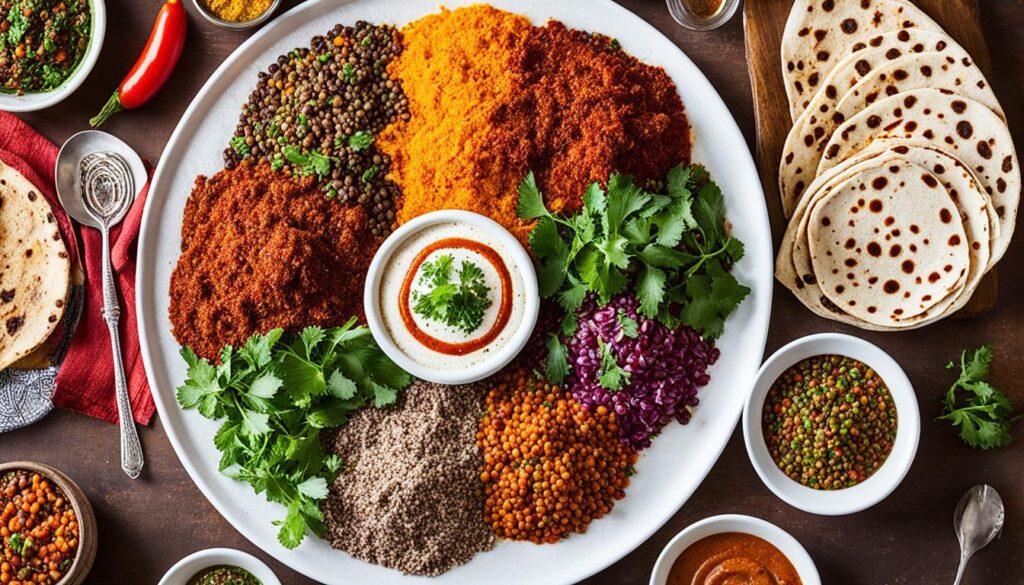
Through these traditional Ethiopian dishes, you’ll experience a culinary journey that showcases the depth and richness of Ethiopian cuisine. Each bite is a testament to the country’s vibrant culture and love for flavorful ingredients. Whether you’re a meat lover or a vegetarian, these dishes will undoubtedly leave you craving for more.
Dietary Preferences in Ethiopian Cuisine
Ethiopian cuisine caters to a diverse range of dietary preferences, making it a haven for those seeking vegetarian, vegan, and plant-based options. With its wealth of flavorful and nutritious dishes, Ethiopian food has become a popular choice among individuals following plant-based diets.
Vegetarians will find a plethora of choices in Ethiopian cuisine, as many traditional Ethiopian dishes feature a variety of vegetables, legumes, and grains. One such popular dish is Misir Wot, a flavorful lentil stew cooked in aromatic spices. Another vegetarian favorite is Gomen, a delicious collard greens dish cooked with onions, garlic, and spices.
For those following a vegan diet, Ethiopian cuisine offers even more options. The absence of dairy products in traditional Ethiopian cooking means that many dishes are naturally free from animal-based ingredients. The staple Ethiopian flatbread, Injera, is typically made using gluten-free teff flour, making it suitable for those with dietary restrictions.
In addition to the vegetarian and vegan options, Ethiopian cuisine also includes a wide variety of plant-based side dishes and snacks. From Shiro, a savory chickpea flour stew, to Timatim Fitfit, a refreshing tomato and bread salad, there are plenty of choices to tantalize your taste buds.
Whether you are a vegetarian, a vegan, or simply looking to incorporate more plant-based options into your diet, Ethiopian cuisine provides a vibrant and flavorful culinary experience. The abundance of vegetarian, vegan, and plant-based dishes ensures that there is something for everyone to enjoy.
Soy in Ethiopian Cuisine
Finally, we approach the main question of our article: does Ethiopian food use soy? In our exploration of Ethiopian cooking, we will delve into the use of soy in both traditional practices and modern adaptations. Gain insight into how soy fits into the culinary landscape of Ethiopia.
Ethiopian cuisine is renowned for its rich and diverse flavors, with a focus on aromatic spices and deeply flavorful ingredients. While soy is not traditionally a central component of Ethiopian dishes, modern adaptations have introduced variations that may include soy-based ingredients.
As the popularity of soy continues to grow globally, some Ethiopian chefs and cooks have incorporated soy-based ingredients into their recipes. This modern twist adds a unique flavor profile and introduces a new dimension to traditional Ethiopian dishes.
Modern Adaptations and the Influence of Soy
With the growing interest in plant-based and vegetarian diets, soy has become a popular protein source for many individuals. In Ethiopian cuisine, soy may be used as a substitute for meat in popular dishes such as doro wat or tibs, providing a vegan-friendly option without compromising on taste.
Furthermore, soy products like tofu or tempeh can be added to various stews, stir-fries, or salads to enhance the texture and nutritional value of the dish. These innovative adaptations embrace the versatility of soy while still honoring the traditional Ethiopian flavors and cooking techniques.
While traditional Ethiopian dishes may not heavily rely on soy, it demonstrates the adaptability of Ethiopian cuisine to modern dietary preferences and culinary trends. The incorporation of soy-based ingredients is a testament to the evolving nature of Ethiopian food and its ability to accommodate diverse tastes and preferences.
So, while soy may not be a staple ingredient in Ethiopian cuisine, its influence is gradually making its way into modern adaptations of traditional dishes. This fusion of flavors ensures that Ethiopian food continues to remain vibrant and relevant in today’s culinary landscape.
Conclusion
Throughout our exploration of Ethiopian cuisine, we have discovered the richness of flavors and the cultural significance behind this truly unique food tradition. While soy is not traditionally a central component of Ethiopian dishes, we have come to learn that modern influences and adaptations have introduced variations that incorporate soy into certain recipes.
Whether you are seeking the authentic flavors of Ethiopia or looking for vegan options, Ethiopian cuisine has something to offer for everyone. From the aromatic spices to the plant-based dishes, this culinary journey has shown us the diverse and delectable world of Ethiopian food.
Join us on more culinary adventures as we continue to explore the global cuisines that bring people together through a shared love for food. From traditional recipes to modern interpretations, let us uncover the flavors and stories that make our meals more than just sustenance but a celebration of culture and connection.



